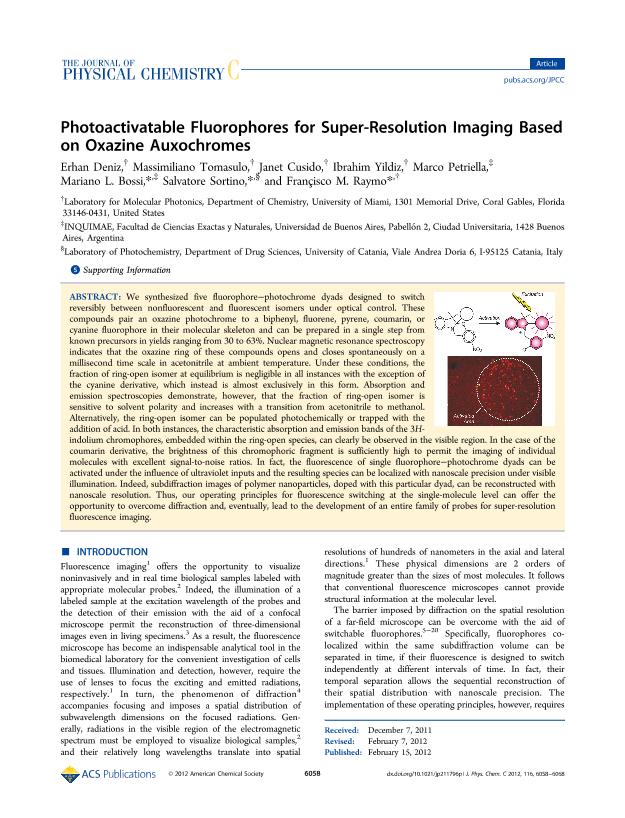Artículo
Photoactivatable Fluorophores for Super-Resolution Imaging Based on Oxazine Auxochromes
Deniz, Erhan; Tomasulo, Massimiliano; Cusido, Janet; Yildiz, Ibrahim; Petriella, Marco ; Bossi, Mariano Luis
; Bossi, Mariano Luis ; Sortino, Salvatore; Raymo, Françisco M.
; Sortino, Salvatore; Raymo, Françisco M.
 ; Bossi, Mariano Luis
; Bossi, Mariano Luis ; Sortino, Salvatore; Raymo, Françisco M.
; Sortino, Salvatore; Raymo, Françisco M.
Fecha de publicación:
03/2012
Editorial:
American Chemical Society
Revista:
Journal of Physical Chemistry C
ISSN:
1932-7447
Idioma:
Inglés
Tipo de recurso:
Artículo publicado
Clasificación temática:
Resumen
We synthesized five fluorophore-photochrome dyads designed to switch reversibly between nonfluorescent and fluorescent isomers under optical control. These compounds pair an oxazine photochrome to a biphenyl, fluorene, pyrene, coumarin, or cyanine fluorophore in their molecular skeleton and can be prepared in a single step from known precursors in yields ranging from 30 to 63%. Nuclear magnetic resonance spectroscopy indicates that the oxazine ring of these compounds opens and closes spontaneously on a millisecond time scale in acetonitrile at ambient temperature. Under these conditions, the fraction of ring-open isomer at equilibrium is negligible in all instances with the exception of the cyanine derivative, which instead is almost exclusively in this form. Absorption and emission spectroscopies demonstrate, however, that the fraction of ring-open isomer is sensitive to solvent polarity and increases with a transition from acetonitrile to methanol. Alternatively, the ring-open isomer can be populated photochemically or trapped with the addition of acid. In both instances, the characteristic absorption and emission bands of the 3H-indolium chromophores, embedded within the ring-open species, can clearly be observed in the visible region. In the case of the coumarin derivative, the brightness of this chromophoric fragment is sufficiently high to permit the imaging of individual molecules with excellent signal-to-noise ratios. In fact, the fluorescence of single fluorophore-photochrome dyads can be activated under the influence of ultraviolet inputs and the resulting species can be localized with nanoscale precision under visible illumination. Indeed, subdiffraction images of polymer nanoparticles, doped with this particular dyad, can be reconstructed with nanoscale resolution. Thus, our operating principles for fluorescence switching at the single-molecule level can offer the opportunity to overcome diffraction and, eventually, lead to the development of an entire family of probes for super-resolution fluorescence imaging. © 2012 American Chemical Society.
Palabras clave:
Fluorescence
,
Photochemistry
,
Photoswitching
,
Nanoscopy
Archivos asociados
Licencia
Identificadores
Colecciones
Articulos(INQUIMAE)
Articulos de INST.D/QUIM FIS D/L MATERIALES MEDIOAMB Y ENERGIA
Articulos de INST.D/QUIM FIS D/L MATERIALES MEDIOAMB Y ENERGIA
Citación
Deniz, Erhan; Tomasulo, Massimiliano; Cusido, Janet; Yildiz, Ibrahim; Petriella, Marco; et al.; Photoactivatable Fluorophores for Super-Resolution Imaging Based on Oxazine Auxochromes; American Chemical Society; Journal of Physical Chemistry C; 116; 10; 3-2012; 6058-6068
Compartir
Altmétricas



